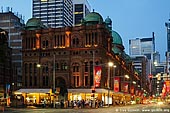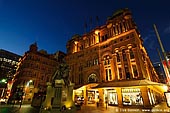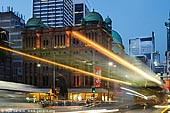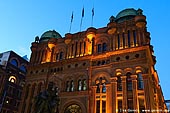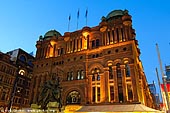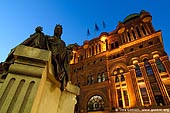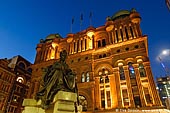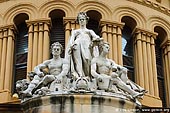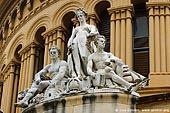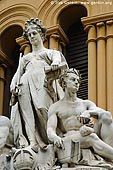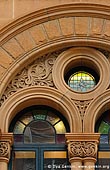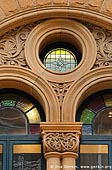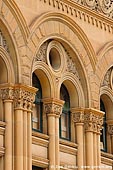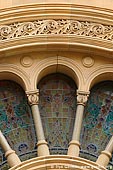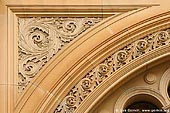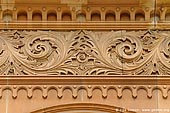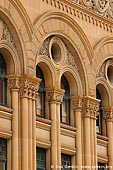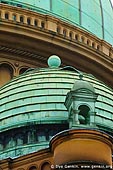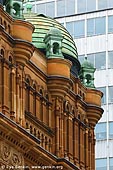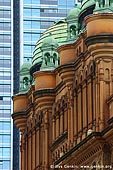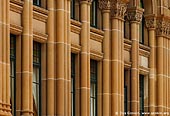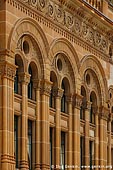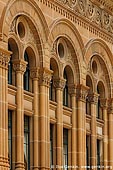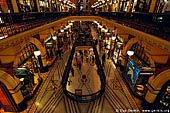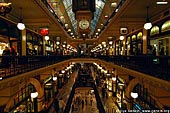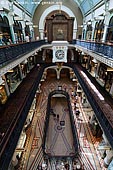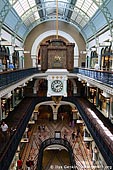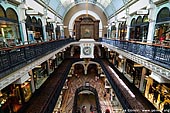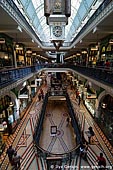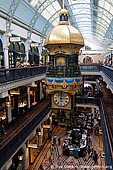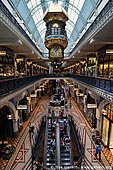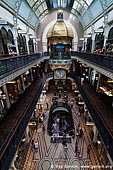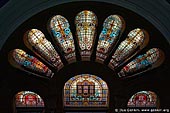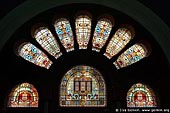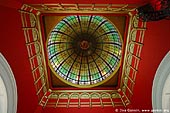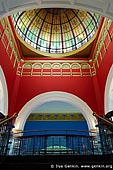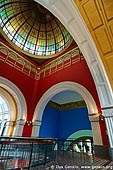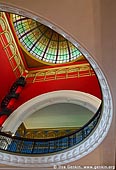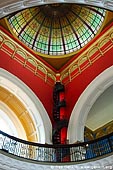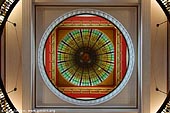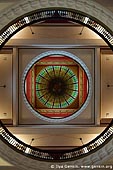Queen Victoria Building (QVB)
Sydney, NSW, Australia
Related subjects: The Strand Arcade
Related subjects: The Strand Arcade
The Queen Victoria Building, also known as the QVB, has been described by fashion designer, Pierre Cardin as "the most beautiful shopping centre in the world". It is both a magnificent historical landmark and a shopping paradise.
The Romanesque Revival building, which occupies an entire city block bound by George, Market, York and Druitt Streets, was built in 1898 by the architect George McRae to replace the original Sydney Markets. Later, it accommodated a concert hall, which eventually became the City Library. The building was remodelled in the 1930s and used for different purposes, including municipal offices. In 1984 it was completely refurbished as a shopping centre, with more than 200 shops. In 2009 another refurbishment finished to keep pace with other commercial buildings in the 21st century. The changes include new shopfronts, glass signage, glazed balustrades, new escalators connecting ground, first and second levels and new colour schemes. The modern changes have been described by critics as kitsch and threatening the heritage values of the historic building. They believe that the new glass and mirrored escalators intrude into space of the original architecture and that the frameless shopfronts, glass signage and new colour schemes have lowered the heritage significance of the whole building.
The dominant feature is the spectacular centre dome, made up of an inner glass dome and an exterior copper-sheathed dome. Smaller domes of various sizes are on the roofline, including a pair overtopping each end of the rectangular building.
Glorious stained glass windows, including a cartwheel window depicting the arms of the City of Sydney, and splendid architecture endure throughout the building and an original 19th century staircase sits alongside the dome. Every detail has been faithfully restored, including arches, pillars, balustrades and the intricate tiled floors thus maintaining the integrity of the building.
Inside, the building consists of four main shopping floors, the top three pierced by voids protected by decorated cast-iron railings. Much of the tilework, especially under the central dome, is original, and the remainder is in keeping with this style. Underground passageways lead off to Town Hall Station at the southern end, and to a food court at the north. You can buy almost anything at the Queen Victoria Building, but be aware that most (not all) stores are fairly upmarket and have the prices to match. Generally, the higher the level, the more expensive the prices are likely to be.
There is a marvellous hanging clock that displays a series of mechanically moving tableaux of British kings and queens every hour on the hour. This spectacular mechanical clock was made by the Queen's clockmaker and resembles Balmoral Castle. It is suspended from the ceiling and is the world's largest hanging animated turret clock. Every hour, on the hour between 9am and 9pm, it's mechanical action figures sound the trumpets and act out a Royal Pageant. It features six scenes from England's history including King John signing the Magna Carta in 1215, Queen Elizabeth I knighting Sir Frances Drake in 1588 and the beheading of Charles I in 1649.
There is also the Great Australia Clock � This clock stands 10 meters tall and depicts 33 scenes from Australia's history from both Aboriginal and European perspectives. An Aboriginal hunter continuously circles the exterior of the clock to represent the never-ending passage of time.
About the Artist
I'm Ilya Genkin - an internationally recognised Australian landscape and fine art photographer offering wall art prints. My passion for capturing the beauty of nature and our world translates into striking photographic prints that bring life, emotion, and inspiration to any space. From tranquil seascapes to dramatic mountainscapes, each image is a reflection of my vision and dedication to the art of photography.
Read more about Ilya Genkin and shop fine art prints online from his collection.
Wall Art Prints Featuring Fine Art Landscape Photography
Explore my extensive collection of wall art prints - crafted with the highest-quality materials to suit every style and budget. Whether you're looking for a luxurious, ready-to-hang piece or a beautifully printed work to frame yourself, each photograph is available in several premium formats: Gallery-quality Fine Art Paper Prints - ready for framing, and Professional Canvas Prints - classic and timeless texture.
Each artwork is meticulously printed and made-to-order to ensure you receive a piece that elevates your home, office, or commercial space. Buy fine art prints online to suit your style.
Artworks for Interior Designers, Home Stylists, and Architects
I collaborate with interior designers, home stylists, and architects to create bespoke wall art prints tailored to your project's aesthetic, colour palette and interior design needs. Prints can be customised and sized to complement your space perfectly. All pieces are made-to-order, and pricing varies based on size, quantity, and shipping.
Contact me to discuss your project and request a personalised quote.
Why Choose Ilya Genkin Photography?
By choosing my work, you're not just acquiring exceptional art - you're supporting an independent Australian artist and contributing to a vibrant local creative community. Every purchase directly helps sustain and grow this craft, bringing authentic and meaningful art into your life.
Request a free mockup to see how a chosen photograph will look in your space before you buy.
Start your journey today - shop our wall art collection, purchase with confidence, or order custom prints today and transform your walls with fine art photography.
Fine Art Landscape Photography
Information
- FAQ - Landscape Photography Prints
- Purchase Fine Art Prints
- Black and White Fine Art Prints
- Art Consultation for Your Home
- Design Tips for Styling Your Space with Art
- Limited Edition vs Open Edition Prints
- Collector Resources
- FAQ - Image Licensing
- License Stock Photos
- Stock Photo Price Request
- Materials and Sustainability
Photography Guides
Online Store Opens 24/7
Email:
Phone: +61 (0) 421 055 613
Crafted with care for the planet - using sustainable materials and eco-friendly packaging.
Ilya Genkin Photography acknowledges the Traditional Custodians of the land on which we operate, live and gather as employees, and recognise their continuing connection to land, water and community. We pay respect to Elders past, present and emerging.
